6R Raymond Mill for Phosphate Rock Grinding: Price and Specifications
Unlocking Phosphate Potential: The 6R Raymond Mill Solution
Phosphate rock grinding represents one of the most demanding applications in mineral processing. The abrasive nature of phosphate compounds, combined with the need for precise particle size distribution, requires robust and efficient grinding equipment. Among the various options available, the 6R Raymond Mill has emerged as a preferred choice for many operations processing phosphate rock for fertilizer production and industrial applications.

Technical Specifications and Performance Metrics
The 6R Raymond Mill, an enhanced version of the traditional Raymond mill design, features six grinding rollers instead of the conventional three or four. This configuration significantly increases grinding capacity while maintaining the reliability that has made Raymond mills industry staples for decades. With an input size capacity of <25mm and throughput ranging from 0.6-5 tph, the 6R model strikes an optimal balance between production volume and energy efficiency.
What sets the 6R Raymond Mill apart in phosphate applications is its ability to handle the material’s specific characteristics. Phosphate rock typically contains varying hardness levels and moisture content, which can challenge less robust grinding systems. The 6R’s optimized grinding curve and reinforced components ensure consistent performance even with fluctuating feed quality.
Beyond Traditional Grinding: Advanced Alternatives
While the 6R Raymond Mill excels in many phosphate grinding scenarios, operations requiring ultra-fine powders should consider our MW Ultrafine Grinding Mill. This advanced system represents the next generation in grinding technology, specifically engineered for customers who need to produce ultra-fine powder with exceptional efficiency.

The MW Ultrafine Grinding Mill handles input sizes of 0-20 mm with capacities ranging from 0.5-25 tph, making it suitable for various production scales. Its innovative design features higher yielding with lower energy consumption – achieving 40% higher production capacity than jet grinding mills with the same fineness and power requirements. The system’s adjustable fineness between 325-2500 meshes, with screening rates achieving d97≤5μm in a single pass, makes it ideal for premium phosphate products demanding precise particle size control.
Environmental considerations are increasingly important in mineral processing, and the MW Ultrafine Grinding Mill addresses these concerns with integrated efficient pulse dust collection and muffler systems that minimize both dust emissions and noise pollution. The absence of rolling bearings and screws in the grinding chamber eliminates common failure points, while external lubrication allows for continuous 24-hour operation without shutdowns for maintenance.
Operational Economics and Return on Investment
The financial justification for selecting grinding equipment extends beyond initial purchase price. For phosphate operations, the 6R Raymond Mill offers compelling operational economics with its proven reliability, readily available spare parts, and straightforward maintenance requirements. The system’s lower investment cost compared to more complex grinding systems makes it particularly attractive for operations with budget constraints or those requiring multiple grinding lines.
However, for operations prioritizing ultimate product value through ultra-fine grinding, the MW Ultrafine Grinding Mill delivers superior return on investment through its remarkable energy efficiency – consuming only 30% of the energy required by jet grinding mills for equivalent output. This efficiency advantage becomes increasingly significant as energy costs rise and environmental regulations tighten.

Frequently Asked Questions
What is the typical production capacity of a 6R Raymond Mill for phosphate rock?
The 6R Raymond Mill typically processes 0.6-5 tph of phosphate rock, depending on the material’s hardness, moisture content, and desired fineness.
How does the MW Ultrafine Grinding Mill achieve higher energy efficiency?
The MW Mill incorporates newly designed grinding curves of the grinding roller and ring that enhance grinding efficiency, along with advanced cage-type powder selector technology that reduces energy consumption during classification.
Can these grinding systems handle variations in phosphate rock quality?
Both systems are designed to accommodate normal variations in feed material. The 6R Raymond Mill provides robust performance across different phosphate grades, while the MW Ultrafine Grinding Mill offers adjustable parameters to optimize performance for specific material characteristics.
What maintenance requirements should be anticipated?
The 6R Raymond Mill follows conventional maintenance schedules for grinding systems, while the MW Ultrafine Grinding Mill reduces maintenance needs through its innovative design that eliminates rolling bearings and screws in the grinding chamber.
How do these systems address environmental regulations?
Both systems incorporate dust collection technology, with the MW Ultrafine Grinding Mill featuring particularly advanced pulse dust collection and noise reduction systems that exceed typical environmental compliance requirements.
